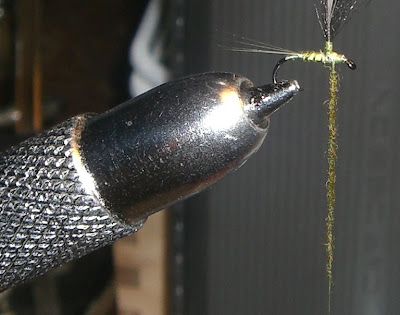I have a very specific pool in mind, it has been featured elsewhere on this blog. As mid Summer approaches, assuming there has been several weeks without rain, the water thins out, atmospheric pressure rises and dusk falls after 22:00. This isn't skinny water, but it is low and slower... more relaxed. These are the conditions to look for when fishing this fly.


Lay a single layer of thread from the eye to the bend. The tail should be tied in directly above the pinched barb. Before adding tailing material, add 2 wraps of flat thread to the bend, simply to colour the hook, rather than add bulk. This provides an extremely subtle, but powerful trigger, suggesting the point of emergence. Split the tail and tie in a goose biot, with the notch facing towards you. Take the thread back towards the front of what will be the thorax.


Apply varnish to the thread body and wrap the biot forward in neat, touching turns. Use hackle pliers to control each wrap. Bind the biot down tigtly with 3-4 turns of flat thread.


Select your preferred winging material, and tie in with a single figure-eight. It is worth taking the time to prepare the wing carefully. The best available is Niche's Siliconised Polypropylene Yarn, which comprises luxurious, stiff fibres. On small, sparse flies it provides superb wing density without unecessary bulk. Take a strand, then brush out the fibres with a fine needle to carefully select the required amount.


Form a stiff and skinny wing post using touching turns of flat thread, no more than a single layer up, and a single layer down and drop the thread behind the wing post. Apply thin varnish to the post.


Carefully select a genetic hackle, checking for even, stiff barbs and tie in with the dull side against the post using a single layer of flat thread. Make open turns to the peak of the post and fill in the gaps with open turns of flat thread back to the base. Add a drop of thin varnish over this. This time, drop the thread in front of the wing post and form a lightly dubbed rope with which to form the thorax.


Form a sparse thorax that tapers slightly fom back to front. Again, take the time to precisely lay every turn of thread/dubbing without crowding the post, head or eye of the hook. Drop the thread in front of the wing post.


Make three wraps of hackle, working down the post and tighly bind the hackle with a single turn of thread. Make a further turn of hackle and again, tighly bind the hackle with a single wrap of thread. This keeps the hackle low against the thorax and abdomen, whilst the last turn neatly aligns the hackle barbs to make for a neat finish. When fished, the thorax and abdomen sit right in the surface film, rather than just above or below it.


Carefully tie off with a three turn whip finish, trim the wing post by pulling level with the hackle and cut at an angle, then apply thin varnish to the head and the top of the wing post. Take care not to contaminate the wing or hackle with varnish.
This was tied on a #19 TMC 102Y BL hook, using Sheer 14/0 olive thread. The permutations of colour are almost infinite, and the pattern can be tied from size 12 to 26. Although sparse, this is an incredibly resilient fly, capable of catching many fish.


When the conditions for which this fly is tied align, I'll report back with a wider description of the approach. Rest assured, every breath and step will be part of the occasion.


2 comments:
hey Andy,
that's a sweet little bug and sbs.
i've been wondering, is the choice of trimming the post at an angle an aesthetic or practical one ?
can't wait to try out the ones you sent !
cheers,
marc
The angled wing is a Davy McPhail tip. Whilst it does represent the rearward slant of the natural's wing, I'm not sure how visible this would be to trout.
It provides a very pleasing aesthetic, and thats the main reason I trim the wing this way.
Thanks Marc.
Andy
Post a Comment